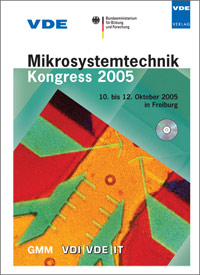Microstructured 2D-Cryobanking and Cryotolerance – Longterm preservation of cells with therapeutical relevance
Conference: Mikrosystemtechnik Kongress 2005 - Mikrosystemtechnik Kongress 2005
10/10/2005 - 10/12/2005 at Munich, Germany
Proceedings: Mikrosystemtechnik Kongress 2005
Pages: 3Language: englishTyp: PDF
Personal VDE Members are entitled to a 10% discount on this title
Authors:
Zimmermann, H.; Katsen-Globa, A. D.; Ehrhart, F. (Abteilung Kryobiophysik & Kryotechnologie, Fraunhofer-Institut für Biomedizinische Technik, 66386 St. Ingbert, Germany)
Feilen, P. J.; Weber, M. M. (Schwerpunkt Endokrinologie und Stoffwechselerkrankungen, Medizinische Klinik und Poliklinik, Universitätsklinik Mainz, 55131 Mainz, Germany)
Sukhorukov, V. L.; Zimmermann, U. (Lehrstuhl für Biotechnologie, Biozentrum, Universität Würzburg, 97074 Würzburg, Germany)
Abstract:
Cryoconservation describes the storage of ‘living’ cells and tissues at temperatures below -130 °C. At these temperatures the vitality, functionality and differentiation of cells is maintained unchanged. Cryoconservation is currently the only method that enables animal, vegetable and in particular human cells and tissues to be kept vital for indefinite periods before reanimation on demand for therapeutic, diagnostic or scientific purposes. The main advantage using microsystems for the storage of multicellular systems and tissue pieces is the avoidance of large temperature gradients while freezing and thawing. The reduced temperature gradients in the smaller cryosubstrates arise from the thermal conductivity of water, which becomes, though small, increasingly important in determining heat flows with decreasing sample size. Thus, both higher freezing and thawing rates or more homogeneous freezing of the samples are possible. Small-sized cryosubstrates also offer the additional advantage of the possibility of the fast and exact addition of cryoprotectant additives by pipette robots. Fast addition results in an immediate and homogeneous distribution of the cryoprotectants. Non-encapsulated Langerhans’ islets cryopreserved in this way were highly functional after thawing despite significantly lower final concentrations of glycerol and dimethyl sulfoxide (DMSO) than usual being applied before freezing. This technical also enables the surface temperature of the sample volume during the freezing and thawing processes to be directly observed by dynamic high-resolution thermo imaging. This could offer significant advantages, for example enabling the excellent quality control of transplants.


